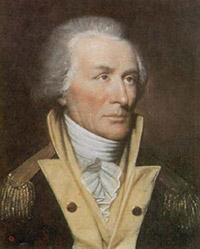|
Royal North Carolina Regiment
The Royal North Carolina Regiment was a provincial corps of Loyalists from the Province of North Carolina during the American Revolution. Provincial corps were regiments with both British and Loyalist forces. Officers * Colonel John Hamilton * Colonel/Captain John Leggett: One of the most prominent Loyalists was John Leggett, a rich planter in Bladen County. He organized and led one of the few loyalist brigades in the South (the North Carolina Volunteers, later known as the Royal North Carolina Regiment). After the war, Colonel Leggett and some of his men moved to Nova Scotia; the British gave them free land grants in County Harbour as compensation for their losses in the colony. The great majority of Loyalists remained in North Carolina and became citizens of the new nation.Carole Watterson Troxler, "'The Great Man of the Settlement': North Carolina's John Leggett At Country Harbour, Nova Scotia, 1783–1812," ''North Carolina Historical Review,'' July 1990, Vol. 67 Issue 3, ... [...More Info...] [...Related Items...] OR: [Wikipedia] [Google] [Baidu] |
Loyalists (American Revolution)
Loyalists were colonists in the Thirteen Colonies who remained loyal to the British Crown during the American Revolutionary War, often referred to as Tories, Royalists or King's Men at the time. They were opposed by the Patriots, who supported the revolution, and called them "persons inimical to the liberties of America." Prominent Loyalists repeatedly assured the British government that many thousands of them would spring to arms and fight for the crown. The British government acted in expectation of that, especially in the southern campaigns in 1780–81. Britain was able to effectively protect the people only in areas where they had military control, and in return, the number of military Loyalists was significantly lower than what had been expected. Due to the conflicting political views, loyalists were often under suspicion of those in the British military, who did not know whom they could fully trust in such a conflicted situation; they were often looked down upon. Pat ... [...More Info...] [...Related Items...] OR: [Wikipedia] [Google] [Baidu] |
Province Of North Carolina
Province of North Carolina was a province of Kingdom of Great Britain, Great Britain that existed in North America from 1712(p. 80) to 1776. It was one of the five Southern Colonies, Southern colonies and one of the Thirteen Colonies, thirteen American colonies. The Monarchy of the United Kingdom, monarch of Great Britain was represented by the List of governors of North Carolina (1712–1776), Governor of North Carolina, until the United States Declaration of Independence, colonies declared independence on Independence Day (United States), July 4, 1776. Etymology "Carolina" is taken from the Latin word for "Charles" (Carolus (name), Carolus), honoring King Charles II of England, Charles II, and was first named in the 1663 Royal Charter granting to Edward Hyde, 1st Earl of Clarendon, Edward, Earl of Clarendon; George Monck, 1st Duke of Albemarle, George, Duke of Albemarle; William Craven, 1st Earl of Craven (1608–1697), William, Lord Craven; John Berkeley, 1st Baron Ber ... [...More Info...] [...Related Items...] OR: [Wikipedia] [Google] [Baidu] |
American Revolution
The American Revolution was an ideological and political revolution that occurred in British America between 1765 and 1791. The Americans in the Thirteen Colonies formed independent states that defeated the British in the American Revolutionary War (1775–1783), gaining independence from the British Crown and establishing the United States of America as the first nation-state founded on Enlightenment principles of liberal democracy. American colonists objected to being taxed by the Parliament of Great Britain, a body in which they had no direct representation. Before the 1760s, Britain's American colonies had enjoyed a high level of autonomy in their internal affairs, which were locally governed by colonial legislatures. During the 1760s, however, the British Parliament passed a number of acts that were intended to bring the American colonies under more direct rule from the British metropole and increasingly intertwine the economies of the colonies with those of Brit ... [...More Info...] [...Related Items...] OR: [Wikipedia] [Google] [Baidu] |
John Hamilton (Loyalist)
John Hamilton (died December 12, 1816) was a military officer in the British Army, and the commander of the Royal North Carolina Regiment of Loyalist provincial volunteers during the American Revolutionary War from 1777 to 1783. Prior to the Revolution, Hamilton was a successful merchant in Halifax, North Carolina, with business interests throughout the Province of North Carolina. Hamilton commanded soldiers in several major engagements, including the battles of Briar Creek, Camden, Guilford Courthouse, and Yorktown. After the conclusion of the war, Hamilton was made British consul to Norfolk, Virginia, one of only three Loyalists to receive consular positions in the newly created United States. Early life and business Born in Scotland, Hamilton immigrated to Nansemond County, Virginia at some point prior to 1760, where other members of his family had already established businesses. Hamilton formed a partnership with two of his brothers, Archibald and William, who had set ... [...More Info...] [...Related Items...] OR: [Wikipedia] [Google] [Baidu] |
Bladen County, North Carolina
Bladen County () , from the North Carolina Collection's website at the . Retrieved 2013-02-08. is a located in the of . As of the [...More Info...] [...Related Items...] OR: [Wikipedia] [Google] [Baidu] |
Battle Of Stono Ferry
The Battle of Stono Ferry was an American Revolutionary War battle, fought on June 20, 1779, near Charleston, South Carolina. The rear guard from a British expedition retreating from an aborted attempt to take Charleston held off an assault by poorly trained militia forces under American General Benjamin Lincoln. Background The opening move in Britain's "southern strategy" to regain control of its rebellious colonies was Admiral Peter Parker and General Henry Clinton's ignominious defeat in June 1776 to a vastly smaller militia force at a partially-constructed palmetto palisade on Sullivan's Island off Charlestown (now Charleston), South Carolina, the Royal Navy's first repulse in a century. In December 1778, however, Savannah was captured and Charleston again exposed to danger. At the time, it was the site of the Continental Army's southern command under General Benjamin Lincoln. The British garrison at Savannah was about the same size as his own. Throughout the early ... [...More Info...] [...Related Items...] OR: [Wikipedia] [Google] [Baidu] |
Siege Of Charleston
The siege of Charleston was a major engagement and major British victory in the American Revolutionary War, fought in the environs of Charles Town (today Charleston), the capital of South Carolina, between March 29 and May 12, 1780. The British, following the collapse of their northern strategy in late 1777 and their withdrawal from Philadelphia in 1778, shifted their focus to the American Southern Colonies. After approximately six weeks of siege, Major General Benjamin Lincoln, commanding the Charleston garrison, surrendered his forces to the British. It was one of the worst American defeats of the war. Background By late 1779, two major British strategic efforts had failed. An army invading from Quebec under John Burgoyne had surrendered to the Americans under Horatio Gates at the Battles of Saratoga, which inspired both the Kingdom of France and Spain to declare war on Great Britain in support of the Americans. Meanwhile, a strategic effort led by Sir William Howe to capt ... [...More Info...] [...Related Items...] OR: [Wikipedia] [Google] [Baidu] |
Battle Of Hanging Rock
The Battle of Hanging Rock (August 6, 1780) was a battle in the American Revolutionary War that occurred between the Patriot (American Revolution), American Patriots and the Kingdom of Great Britain, British. It was part of a campaign by militia General Thomas Sumter to harass or destroy British outposts in the South Carolina back-country that had been established after the fall of Charleston, South Carolina, Charleston in May 1780. Future President Andrew Jackson (aged 13) and his brother Robert partook in the battle. Background Throughout 1779 and early 1780, the British "Southern theater of the American Revolutionary War, southern strategy" to regain control of its rebellious provinces in the American Revolutionary War went well, with successful amphibious operations against Capture of Savannah, Savannah, Georgia and Siege of Charleston, Charleston, South Carolina, and a routing of the few remaining Continental Army troops in South Carolina in the May 29, 1780 Battle of Wax ... [...More Info...] [...Related Items...] OR: [Wikipedia] [Google] [Baidu] |
Battle Of Camden
The Battle of Camden (August 16, 1780), also known as the Battle of Camden Court House, was a major victory for the British in the Southern theater of the American Revolutionary War. On August 16, 1780, British forces under Lieutenant General Charles, Lord Cornwallis routed the numerically superior U.S. forces led by Major General Horatio Gates about four miles north of Camden, South Carolina, thus strengthening the British hold on the Carolinas following the capture of Charleston. The rout was a personally humiliating defeat for Gates, the U.S. general best known for commanding the American forces at the British defeat at Saratoga three years previously. His army had possessed a great numerical superiority over the British force, having twice the personnel, but his command of them was seen as disorganized and chaotic. Following the battle, he was regarded with disdain by his colleagues and he never held a field command again. His political connections, however, helped him a ... [...More Info...] [...Related Items...] OR: [Wikipedia] [Google] [Baidu] |





